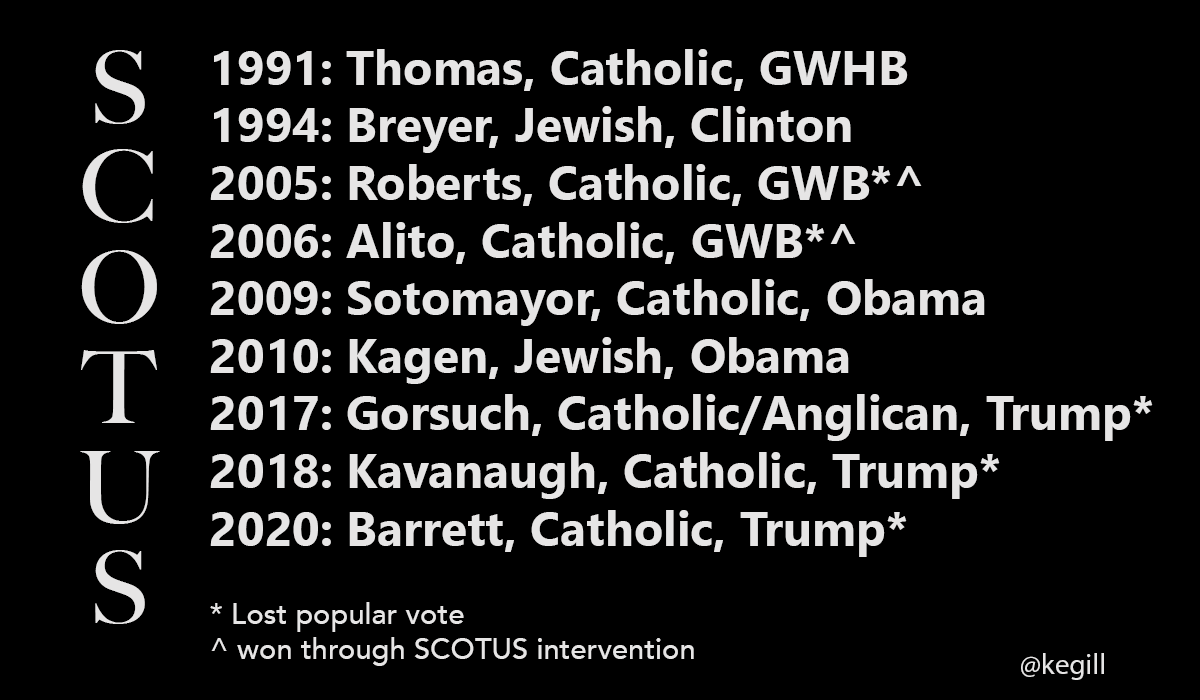
For several years, I’ve believed that this union of 50 states teetered precariously.
That I lived in a country which could collapse into a second civil war, but probably not in my lifetime.
Today, I have no confidence in that timeline.
We are no longer being governed through “the consent of the majority.” Instead, we are being governed by demands of the minority, law that infringes upon the “inalienable rights” of the majority.
This week, the Supreme Court of the United States (SCOTUS or Court) reversed established precedent. Twice.
On Thursday, the Court overturned a New York state law (6-3) that has been on the books for more than a century. In so doing, it is also undoing two centuries of its own decisions.
On Friday, the Court overturned (5-4) a federal decision made in 1973 (7-2). In so doing, it is “rescinding an individual right in its entirety and conferring it on the State, an action the Court takes for the first time in history (emphasis added).”
The justices who voted against precedent on Friday were nominated by presidents who failed to win the popular vote in their election.
They were confirmed by a Senate where Republicans, the party in power, did not represent a majority of the American population. The last time that happened was 1996.
Thus these are illegitimate decisions when viewed through the majority rule “principle of republicanism” that the founders relied upon when constructing this constitutional republic.
An illegitimate Court overturns Roe v Wade
In 1973, a conservative Court upheld the right to abortion in a 7-2 decision. Of the seven, five had been appointed by a Republican president.
The author of the opinion in Roe v Wade, Harry A. Blackmun, was appointed by Richard Nixon in 1970. The other six concurring justices: Lewis F. Powell Jr. (Nixon, 1971); Chief Justice Warren Berger (Nixon, 1969); Thurgood Marshall (Johnson, 1967); Potter Stewart (Eisenhower, 1959); William J. Brennan Jr. (Eisenhower, 1957); William O. Douglas (FDR, 1939).
In contrast, this is the composition of the Court that overturned a 49-year precedent in a 5-4 ruling Friday.

Although George W. Bush (R) became president in 2001, he lost the popular vote to Al Gore (D). In addition, the SCOTUS intervened in Florida’s recount. In so doing, the Court overruled state law in an unsigned opinion (5-4). Bush would run successfully for a second term; given the incumbent advantage in American politics, this is the norm rather than the exception.
Bush appointed two justices: John Roberts in 2005 (Chief Justice) and Samuel Alito in 2006 (associate justice). Alito’s was the controversial nomination. A Catholic, Alito had written in 1985 that the Department of Justice “should make clear that we disagree with Roe v. Wade.”
The Senate Judiciary Committee split along party lines on the motion to move his nomination to the full Senate. It had been 90 years since the committee had forwarded a nomination on a party-line vote: Louis D. Brandeis in 1916.
Alito told Sen. Arlan Specter (R-PA), a supporter of a woman’s right to autonomy, that following precedent is “very important.” He said overturning prior decisions required “special justification.” He also said that there was no “inexorable command” to follow precedent.
With piercing foresight, The Nation wrote in 2006 that Alito’s confirmation “would swing the Supreme Court to a right-wing authoritarianism that is out of step with the public and the Constitution.” He was confirmed in the Senate on a 58-42 party-line vote, “one of the closest in U.S. history.” Try not to laugh (or grimace) at how much has changed in two presidencies.
Did Alito lie to the Senate? I believe he lied by omission. He was asked a straight question; he gave a sleight-of-hand answer.
Donald Trump / Mitch McConnell nominees were asked specifically about Roe v Wade. They lied under oath unless they’re planning to redefine “precedent.” Like Alito before them, they dodged. Any Senator who actually believed that dodge was being willfully deaf and blind.
Here’s Neil Gorsuch (54-45)
Roe v. Wade, decided in 1973, is a precedent of the U.S. Supreme Court… It was reaffirmed in Casey in 1992 and in several other cases. So a good judge will consider it as precedent of the U.S. Supreme Court worthy as treatment of precedent like any other.
And Brett Kavanaugh (52-48)
[Roe v Wade] is settled as a precedent of the Supreme Court, entitled the respect under principles of stare decisis. And one of the important things to keep in mind about Roe v. Wade is that it has been reaffirmed many times over the past 45 years, as you know, and most prominently, most importantly, reaffirmed in Planned Parenthood v. Casey in 1992.
Finally, Amy Coney Barrett (52-48)
I don’t have any agenda. I have no agenda to try to overrule Casey… I will follow the law of stare decisis, applying it as the court is articulating it, applying all the factors, reliance, workability, being undermined by later facts in law, just all the standard factors. And I promise to do that for any issue that comes up, abortion or anything else. I’ll follow the law.
This Court is out of step with public opinion
Let’s start with religion.
Only 1-in-5 Americans are Catholic; more than half of them support women’s autonomy. About 1-in-3 (a larger percentage) Americans are religiously unaffiliated.
However, all five justices who voted to overturn Roe are Catholic.
- 64 percent of US Catholics (and 40 percent of Catholic Republicans) believe abortion should be legal in most or all cases
- 65 percent of all adult Americans hold that view
How did abortion became a political football wielded by evangelicals and the GOP?
- Colonial America: not illegal nor considered murder by church officials
- Then laws focused on patent medicines and abortions after quickening, when the fetus begins to move (~16 weeks).
- The Catholic Church position on abortion dates from 1869
- The Southern Baptist Convention supported “opening up access to abortion in many cases in 1971, and then they reaffirmed that in 1974 and in 1976.”
About 1-in-4 Americans are evangelical Protestants. For them, the issue of abortion is inextricably tied to social order. Here’s Kristin Kobes Du Mez, professor of history and gender studies at Calvin University:
[F]or evangelicals, conservative evangelicals, gender difference is really foundational to their understanding of the social order. And they believe that God created men and women to be very different, even opposites. And the women’s primary calling is that of wife and mother. And so abortion also really severs that kind of biological or social relationship or threatens to do so. And for that reason, also, abortion is such a priority for evangelicals because it kind of strikes at the heart of their understanding of women and men and their understanding of how God has ordered society.
The latest Gallup poll is a testament to this disconnect. Only 1-in-4 Americans have a “Great deal/Quite a lot” of confidence in the SCOTUS, a record low. Two years ago, that was 2-in-5.
When Joe Biden was confirmed by the Senate on 06 January 2021, Senate Democrats represented 41,549,808 more citizens than Republican Senators.
In the 2020 Electoral College, each California elector represented 678,945. In Wyoming, it was 189,433.
In 1776, a group of North American colonists told England that they weren’t willing to pay a tax on paper, with revenue used to expand the Empire, when they had no say in said tax.
In November 2022, will the majority of Americans show the minority that they no longer get to impose their beliefs on the rest of us? If we are unsuccessful, then I fear we will no longer teeter. We will fall.
Header image: Adobe Stock Photo (licensed)
Known for gnawing at complex questions like a terrier with a bone. Digital evangelist, writer, teacher. Transplanted Southerner; teach newbies to ride motorcycles. @kegill (Twitter and Mastodon.social); wiredpen.com
















